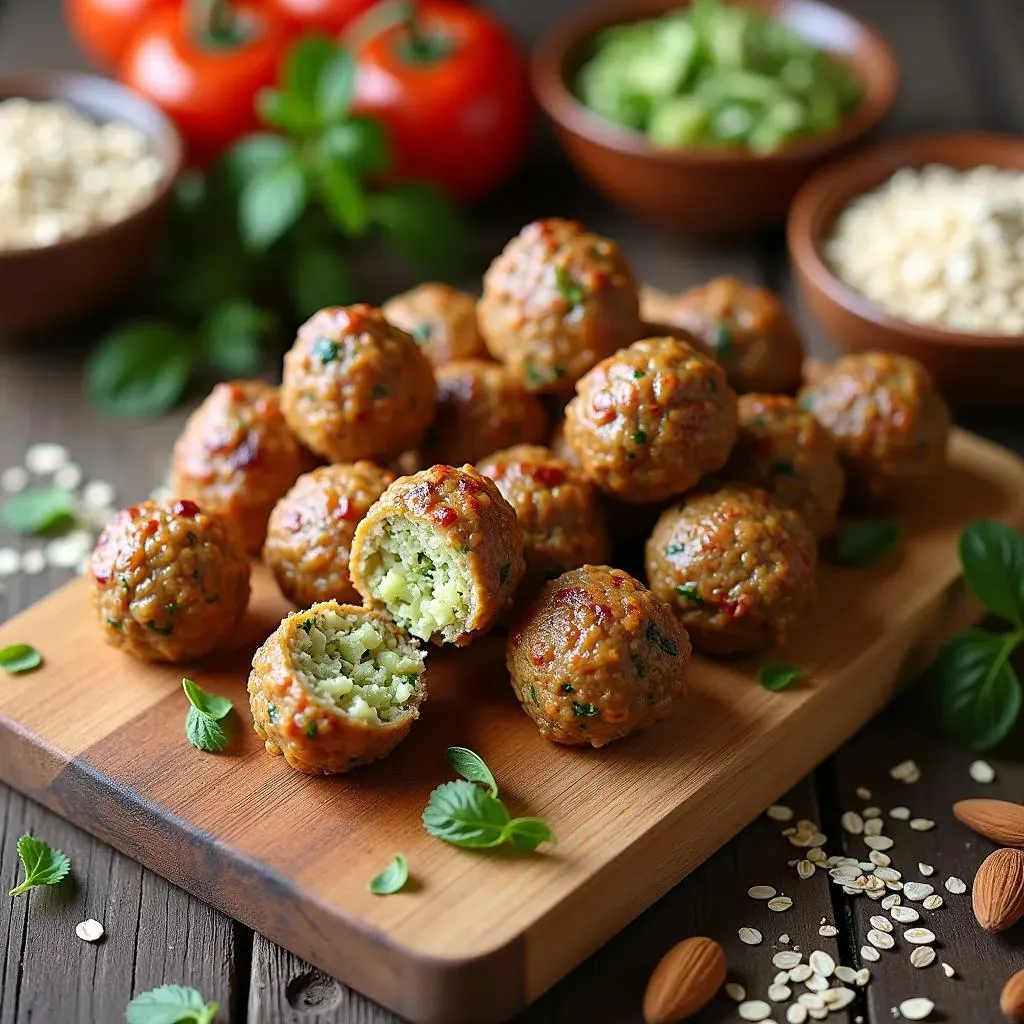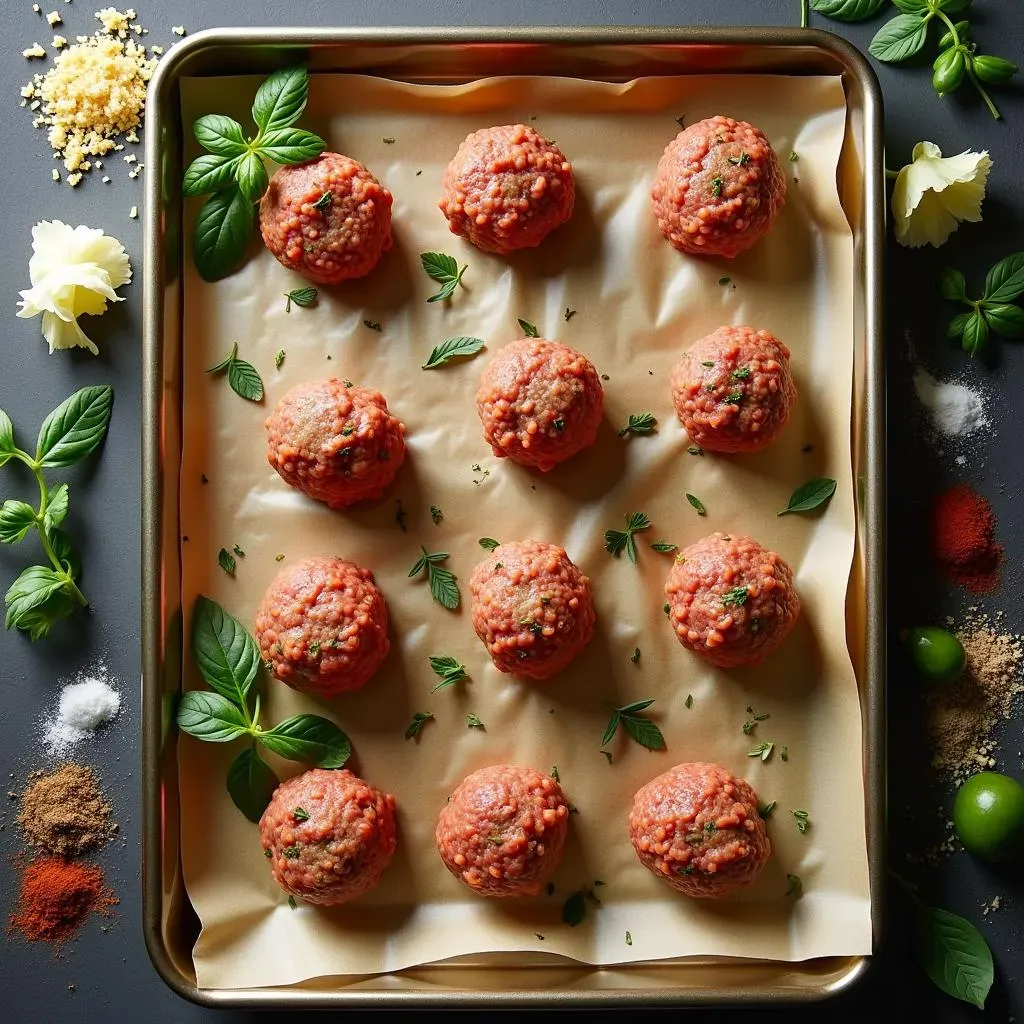Table of Contents
Who doesn't love a good meatball? They're comforting, versatile, and a guaranteed crowd-pleaser. But let's be honest, traditional meatball recipes can be a bit heavy on the unhealthy side. That's where this **healthy homemade meatballs recipe** comes in! We're ditching the excess fat and processed ingredients without sacrificing any of the flavor you crave. This isn't just about making meatballs healthier; it's about making them better. Think lighter, more flavorful, and packed with nutrients. Ready to transform your meatball game? We'll walk you through why making your own meatballs is a game-changer, the simple ingredient swaps that make all the difference, and a step-by-step guide to crafting the perfect batch. Plus, we'll share creative serving ideas and make-ahead tips so you can enjoy these healthy meatballs any night of the week. Get ready to roll!
Why Make Your Own Healthy Homemade Meatballs?

Why Make Your Own Healthy Homemade Meatballs?
Control What Goes In
Let's face it, store-bought meatballs can be a mystery. What kind of meat are they using? What fillers are bulking them up? And what about all those sneaky preservatives and sodium? When you make your own healthy homemade meatballs, you're in complete control. You get to choose high-quality, lean ground meat (or even a plant-based alternative!), fresh herbs, and wholesome ingredients. No more guessing games – just pure, delicious goodness.
Think of it like this: you wouldn't let a stranger pick out your groceries, right? So why let them decide what goes into your meatballs? Take charge of your ingredients and create a meatball masterpiece that you can feel good about eating.
Healthier Than Store-Bought
Beyond just knowing what's in them, homemade meatballs can be significantly healthier than their pre-made counterparts. You can reduce the amount of saturated fat by using leaner meats and baking instead of frying. You can also sneak in extra veggies like finely grated zucchini or carrots for added nutrients and moisture. Plus, you can control the sodium content, which is often sky-high in store-bought versions.
It's all about making smart choices. A few simple tweaks can transform a potentially unhealthy dish into a nutritious and satisfying meal. And the best part? You won't even notice the difference in taste! Here's a quick comparison:
Nutrient | Store-Bought Meatballs (per serving) | Homemade Healthy Meatballs (per serving) |
|---|---|---|
Calories | 250 | 180 |
Saturated Fat | 10g | 5g |
Sodium | 500mg | 250mg |
Taste the Difference
so maybe you're convinced that homemade is healthier, but what about the taste? Trust me, once you've tried a batch of freshly made meatballs, you'll never go back to the frozen kind. The flavor is just so much brighter and more complex. The fresh herbs, the perfectly browned meat, the subtle hint of garlic and onion – it's a symphony of deliciousness in every bite.
And let's not forget the satisfaction of creating something amazing from scratch. There's a certain pride that comes with knowing you made these meatballs with your own two hands. So ditch the processed stuff and experience the joy of homemade. Your taste buds (and your body) will thank you!
The Secret to Healthy Homemade Meatballs: Ingredient Swaps

The Secret to Healthy Homemade Meatballs: Ingredient Swaps
Lean Meat Choices
The foundation of any good meatball is, well, the meat! But not all meat is created equal. To keep things healthy, opt for leaner choices. Ground turkey or chicken breast are excellent alternatives to traditional ground beef. They're lower in saturated fat and calories, but still provide plenty of protein.
If you're a beef lover, don't worry, you don't have to ditch it completely. Just choose a lean ground beef, like 90% lean or higher. You can also try a blend of lean ground beef and ground turkey or chicken for a balanced flavor and texture.
Bye-Bye Breadcrumbs, Hello Alternatives
Traditional meatball recipes often call for breadcrumbs as a binder. But breadcrumbs can be high in carbs and low in nutrients. Luckily, there are plenty of healthier alternatives that work just as well, if not better!
Consider using rolled oats, quinoa flakes, or almond flour instead. These options add fiber, protein, and healthy fats to your meatballs, making them more nutritious and satisfying. Plus, they help to bind the ingredients together perfectly.
Here's a quick rundown of breadcrumb alternatives:
- Rolled Oats: A great source of fiber and helps retain moisture.
- Quinoa Flakes: Adds a nutty flavor and boosts the protein content.
- Almond Flour: A low-carb option that adds a subtle sweetness.
Veggie Power-Up
Want to sneak in some extra nutrients without sacrificing flavor? Add finely grated vegetables to your meatball mixture! Zucchini, carrots, and onions are all excellent choices. They add moisture, fiber, and a boost of vitamins and minerals.
Don't worry, you won't taste them too much. The vegetables will blend seamlessly into the meatball mixture, adding a subtle sweetness and enhancing the overall flavor. It's a win-win!
As an example, my cousin Sarah always adds grated zucchini to her meatballs. Her kids never even notice, and they get an extra serving of veggies without a fight!
StepbyStep: Crafting the Perfect Healthy Homemade Meatballs Recipe

StepbyStep: Crafting the Perfect Healthy Homemade Meatballs Recipe
Get Your Ingredients Ready
Alright, let's get down to business! First things first, gather all your ingredients. This is crucial because it ensures you won't be scrambling mid-recipe. You'll need your lean ground meat (turkey, chicken, or lean beef), your breadcrumb alternative (rolled oats, quinoa flakes, or almond flour), your veggies (grated zucchini, carrots, or onions), eggs, herbs, spices, and any other flavor boosters you want to add.
Pro-tip: Mince your garlic and onions finely. Nobody wants a giant chunk of garlic in their meatball! Also, make sure your eggs are lightly beaten. This helps them incorporate evenly into the mixture.
Mix It Up Like a Pro
Now for the fun part! In a large bowl, combine all your ingredients. But here's the key: don't overmix! Overmixing can lead to tough meatballs. Gently combine everything until just incorporated. I like to use my hands for this, but a wooden spoon works too.
Once everything is mixed, it's time to test the seasoning. Take a small spoonful of the mixture and cook it in a pan. Taste it and adjust the seasoning as needed. This is your chance to make sure the meatballs are perfectly seasoned to your liking. Here's a simple checklist to follow:
- Salt: Enhances the overall flavor.
- Pepper: Adds a touch of spice.
- Garlic: Provides a savory kick.
- Herbs: Adds freshness and complexity.
Shape, Bake, and Enjoy
Preheat your oven to 375°F (190°C). While the oven is heating, it's time to shape your meatballs. Use a spoon or your hands to form the mixture into evenly sized balls. I usually aim for about 1-inch in diameter.
Place the meatballs on a baking sheet lined with parchment paper. This prevents them from sticking and makes cleanup a breeze. Bake for 20-25 minutes, or until the meatballs are cooked through and lightly browned. Let them cool slightly before serving. Now you have the perfect healthy homemade meatballs!
Serving Suggestions: Beyond Spaghetti with Your Healthy Homemade Meatballs

Serving Suggestions: Beyond Spaghetti with Your Healthy Homemade Meatballs
Meatball Subs with a Healthy Twist
so spaghetti and meatballs are a classic for a reason, but let's think outside the pasta box for a minute. How about meatball subs? Instead of using regular white bread, opt for whole-wheat rolls or even better, some hearty ciabatta. Load them up with your healthy homemade meatballs, a dollop of marinara sauce (look for low-sodium options!), and a sprinkle of part-skim mozzarella. Then, broil them until the cheese is melted and bubbly. It's a satisfying and delicious meal that's way healthier than your average sub.
For an extra veggie boost, sneak in some sliced bell peppers or onions under the cheese. Trust me, it adds a ton of flavor and nutrients. And if you're feeling adventurous, try a pesto mayo instead of marinara for a unique twist.
Meatball Bowls: The Customizable Delight
Meatball bowls are where it's at! They're super versatile, easy to customize, and perfect for meal prepping. Start with a base of your favorite grain: quinoa, brown rice, or even cauliflower rice for a low-carb option. Then, add your healthy homemade meatballs and load up on the veggies. Think roasted broccoli, sautéed spinach, chopped cucumbers, or anything else your heart desires. Drizzle with a flavorful sauce like a lemon-tahini dressing or a spicy sriracha mayo. Boom! You've got a healthy and delicious meal in a bowl.
My friend Jessica makes meatball bowls every week for lunch. She says it's the easiest way to get a balanced meal on the go. She usually preps all the ingredients on Sunday and then just assembles the bowls each morning. Genius!
Storing and Reheating: Make Ahead Tips for Your Healthy Meatballs

Storing and Reheating: Make Ahead Tips for Your Healthy Meatballs
Make Ahead Like a Boss
Life's busy, right? That's why making meatballs ahead of time is a total game-changer. You can prep the meatball mixture a day or two in advance and store it in the fridge. Just cover it tightly with plastic wrap to prevent it from drying out. When you're ready to cook, simply shape the meatballs and bake them as directed. It's a huge time-saver on those hectic weeknights.
Another option is to fully cook the meatballs ahead of time and then store them in the fridge. This is perfect if you're meal prepping for the week or if you're expecting guests and want to get a head start on the cooking. Just make sure to let the meatballs cool completely before storing them.
Freezer-Friendly for Future You
Did you know meatballs freeze like a dream? This is a fantastic way to have healthy, homemade meatballs on hand whenever you need them. To freeze, arrange the cooked meatballs in a single layer on a baking sheet lined with parchment paper. Pop them in the freezer for about an hour, or until they're frozen solid. Then, transfer them to a freezer-safe bag or container. This prevents them from sticking together and makes it easy to grab just a few meatballs at a time.
When you're ready to use the frozen meatballs, you can thaw them in the fridge overnight or reheat them directly from frozen. Just add a few extra minutes to the cooking time. Here's a quick guide:
- Thawing in the Fridge: Place meatballs in the refrigerator for 8-12 hours.
- Reheating from Frozen: Add 5-10 minutes to the original cooking time.
Reheating Done Right
Reheating meatballs is super easy, but there are a few things to keep in mind to prevent them from drying out. The best way to reheat meatballs is in a sauce. Simmer them in your favorite marinara or gravy until they're heated through. This will keep them moist and flavorful.
You can also reheat meatballs in the oven. Place them in a baking dish with a little bit of sauce or water to prevent them from drying out. Cover the dish with foil and bake at 350°F (175°C) until heated through. Avoid reheating meatballs in the microwave, as this can make them rubbery.
Here's a comparison of reheating methods:
Method | Pros | Cons |
|---|---|---|
Simmering in Sauce | Keeps meatballs moist and flavorful | Requires sauce |
Oven | Evenly reheats meatballs | Can dry out meatballs if not covered |
Microwave | Fastest method | Can make meatballs rubbery |
Conclusion: Your New Go-To Healthy Homemade Meatballs Recipe
So there you have it! A delicious, nutritious, and easy **healthy homemade meatballs recipe** that's sure to become a family favorite. By making a few simple swaps and embracing fresh ingredients, you can enjoy all the comfort of classic meatballs without the guilt. Whether you're serving them over zucchini noodles, adding them to a hearty soup, or enjoying them as a protein-packed snack, these meatballs are a versatile and satisfying option. Now, go get rolling and enjoy the incredible flavor of homemade!